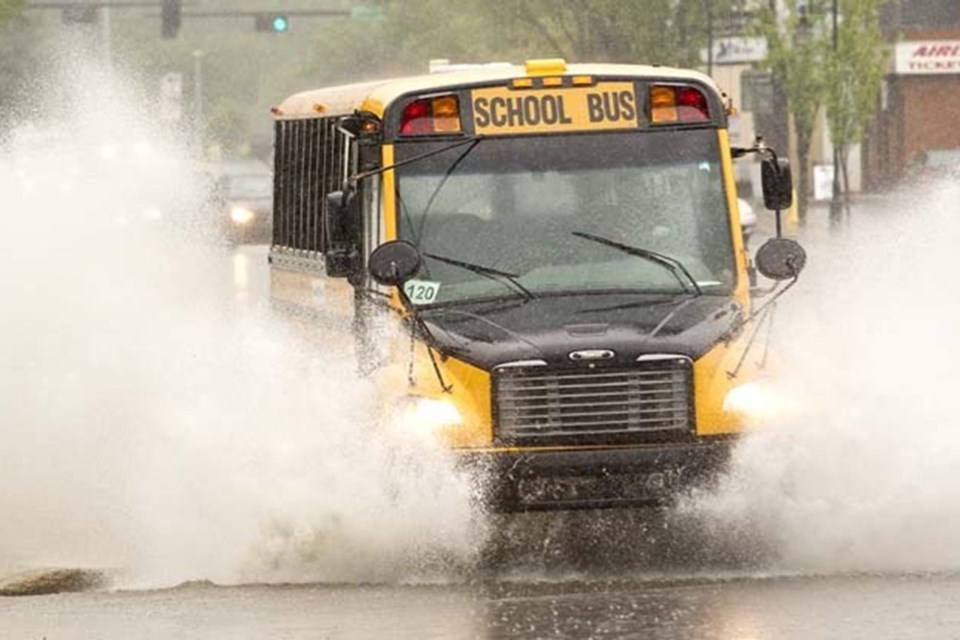Great West Media has received federal government funding through the Local Journalism Initiative to support a reporter to cover climate in Alberta.
Jen Henderson will feature in-depth reporting on where Alberta is at with actions to reduce carbon emissions and generation of less carbon-intensive energy, along with climate issues across the province as they intersect with industry, business, the environment, the economy, communities, and lifestyles.
Please email [email protected] with story ideas.
Communities in northern Alberta are seeing spring flooding and experts say Alberta must do more to prepare for flooding in the future.
The Métis settlement of Paddle Prairie, home of around 800 people, has faced massive floods in recent days, and many homes are without running water.
Ryan Ness, director of adaptation at the Canadian Climate Institute, said extreme weather and flooding are going to become more frequent in the future and damages can range from $1 billion per year currently to more than $10 billion a year by the end of the century, depending on the amount of climate change seen in Canada.
To deal with the flooding on Canada's doorstep, Ness said approaches to manage flood risks across the country have been inconsistent.
“There's no sort of co-ordinated national approach or national standards, laws, regulations,” Ness said.
“We don’t have standard data available for the entire country on what and where there is a risk of flooding,” Ness said.
Flood maps in the country only cover half of the properties and assets, and those maps are on average more than 20 years old.
“We don't even have a starting point to manage our risk of flooding and to prepare for the impacts of climate change,” Ness said.
Alberta has faced multiple big weather events which have caused substantial damage in the past several years, with five out of the 10 most expensive disasters happening in Alberta, including the southern Alberta floods in 2013 and the Fort McMurray floods in 2020.
Experts say these events will happen more frequently as the climate changes.
“We will see big flood events occur more often and it’s possible that the biggest flood events will be bigger than they have been in the past,” Ness said.
“As the climate warms, there is more energy to create storms and more water in the atmosphere to drop down.”
These big events will have big impacts on infrastructure across the country.
Public infrastructure such as roads, telecommunication systems, and water treatment plants, are all at risk of inland flooding or coastal flooding, and Ness said it can be critical when these services are shut down.
Property is also at risk, Ness said, with some estimates putting 10 per cent of Canada’s real estate at risk of flooding in a 100-year flood.
“It’s a major problem and it's everywhere,” Ness said.
Many communities don’t start examining their flood risk until a flood has already occurred and residents want to prevent it from happening again, said Ness.
Any cities built along a river and in a flood plain are at risk, such as Calgary, Winnipeg, and Ottawa, said Ness.
But even smaller communities, such as Paddle Prairie, are at risk for major flooding events, and Ness said many smaller communities just don’t have the resources to do flood mapping and build damns to prevent damage.
Province-to-province flood mapping and planning varies wildly, and is often downloaded onto municipalities, Ness said, leaving the country with a patchwork approach.
“It's an uneven playing field as well as an inconsistent playing field,” Ness said.
Paul McLauchlin, president of the Rural Municipalities of Alberta, said small communities across the province are advocating for support in climate-change resiliency. McLauchlin said communities want to make sure they aren’t completely isolated if their single bridge in and out of town is washed out in a flood.
Being resilient to flooding and other climate issues is a big deal for small communities, McLauchlin said.
“It’s a discussion that we should all have now before it does occur,” McLauchlin said.
Municipalities are in a “grey area” when it comes to planning for climate change, because they are responsible for land-use planning in their communities, however the province deals with water.
“I think that we need to work together with the provincial and federal government to have that discussion, and to ensure that these plans are in place,” McLauchlin said.
According to the Canadian Climate Institute report Under Water, released last year, Alberta, Quebec, and Ontario will bear the largest overall costs from climate-change damage to their roadways as they are the regions with the most extensive road networks. As early as mid-century, damage induced by climate change will cost those provinces hundreds of millions more to maintain their road networks, under the lower-emissions scenario, the report said.
Rail lines will also be impacted by climate change, with damage estimated to cost $1 million to $180 million per year depending on the time frame and emissions scenario, according to the report.
Electrical transmission lines could see damage worth $2.4 billion annually by mid-century from climate change and about $3.6 billion annually by the end of the century under a high-emissions scenario, while in a low-emissions scenario the damage would average $1.8 billion annually
To bring infrastructure across the country up to a standard to be more resilient to climate disaster, such as flooding, estimates in the report say it could cost the country $250 billion.
McLauchlin said designing infrastructure to be resilient to major events is important to mitigate some of the damage from the big climate disasters that are coming.
"Resiliency is a huge discussion for all Albertans ... [We must be] making sure that we have these resilient communities, ensuring that we know who's at risk and who's not, and seeing if we can design infrastructure and mitigate now before there are terrible disasters."



